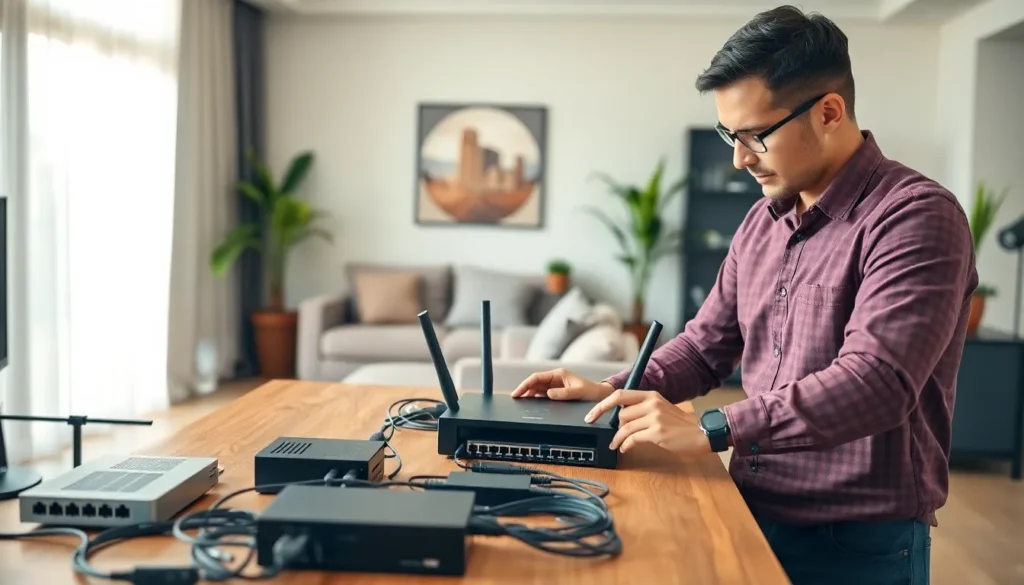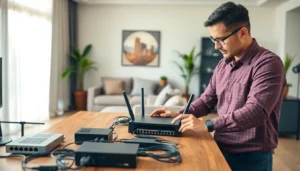Table of Contents
ToggleIn today’s hyper-connected world, where streaming cat videos at lightning speed is crucial (because that’s the real priority, right?), a robust home network is not just a luxury, it’s a necessity. You wouldn’t trust your delicate china to a clumsy six-year-old, so why entrust your home networking needs to just anyone? Understanding the ins and outs of home networking installation services is essential to ensure smooth sailing through the digital seas of your home. Let’s jump into this must-have guide that’ll have your network running as flawlessly as your morning coffee brews.
Understanding Home Networking

Home networking involves connecting various devices in a home environment to share resources and access the internet. Imagine a bustling coffee shop, the baristas (devices) connect customers (users) to Wi-Fi while seamlessly managing orders (data flows). This intricate dance is what home networking strives to replicate, ensuring every device, from smart TVs to gaming consoles, functions harmoniously in a digital ecosystem.
But let’s not get ahead of ourselves. Understanding home networking comprises grasping the basic components involved: routers, switches, and access points. Each of these plays a pivotal role in establishing a fluid network that spans the entire home, facilitating everything from web browsing to video conferencing.
Types of Home Networking Technologies
Diving deeper, home networking technologies can be broadly categorized into wired and wireless systems.
Wired Networking
Wired connections use Ethernet cables for direct links between devices. This setup typically offers faster speeds and greater reliability. Think of it as a well-connected train system that gets you from point A to point B without delays. The downside? You might trip over those cables if you’re not careful.
Wireless Networking
On the other hand, wireless networks use Wi-Fi to help connections without physical cables. These setups are incredibly convenient, allowing users to move freely throughout their space with portable devices. But, they can be susceptible to interference from other electronic devices and thick walls.
Also, technologies such as Powerline adapters and mesh networks are also gaining traction. The former use electrical wiring to transmit data, while the latter creates a blanket of Wi-Fi coverage throughout your home. Each option has unique advantages and can be suited to different living arrangements.
Benefits of Professional Installation Services
Some might wonder, “Isn’t this something I can do myself?” While DIY home networking might sound tempting, professional installation services offer undeniable benefits.
First and foremost, expertise matters. Skilled technicians know the ins and outs of networking, from choosing the right equipment to ensuring optimal placement for coverage. No more guessing games or enduring hours of head-scratching troubleshooting.
Also, professional services save time. Why spend your weekend wrestling with cables and settings when experts can have it all configured in a fraction of the time? They’ll even test the network to ensure everything operates as intended. Plus, many services provide ongoing support. Should a hiccup arise down the road, you’ll have a reliable source to turn to.
Key Considerations for Home Networking Installation
Before embarking on a home networking installation, specific considerations need attention.
Size and Layout
The size and layout of the home play a significant role. Larger homes may require additional access points or mesh systems to ensure complete coverage.
Internet Speed Requirements
Understanding your household’s internet usage is crucial. For those who stream, game, or work from home, higher speeds and bandwidth will be necessary. A chatty household with many devices will need a more robust setup than a quiet one.
Equipment Selection
Selecting the right devices is integral to success. Investing in quality routers and switches can drastically improve performance. Sometimes, going with the lesser-known brands can unlock surprisingly great deals, but do check reviews to ensure you’re not going for a lemon.
Step-by-Step Guide to Home Networking Installation
A successful home network requires a few crucial steps. Let’s break it down:
Step 1: Determine Your Needs
Assess the number of devices and their locations. Knowing how many laptops, phones, and smart appliances you have will guide equipment choices.
Step 2: Choose Your Equipment
Based on needs, select the appropriate router and any additional networking gear. Consider future-proofing by choosing a router that supports the latest Wi-Fi standards.
Step 3: Set Up the Router
Position your router in a central location to promote optimal coverage. Connect it to your modem (if applicable) and power it on.
Step 4: Configure Settings
Use the admin interface (usually accessed through a web browser) to configure security settings, Wi-Fi name, and password.
Step 5: Connect Devices
Once the basic setup is complete, connect your devices. Ensure they are receiving a proper signal and addressing any connectivity issues as needed.
Step 6: Test the Network
Finally, run a few speed tests and check for dead zones. Adjust placements of access points as necessary until a strong, stable connection is achieved.
Troubleshooting Common Networking Issues
Even after a successful installation, hiccups may still occur. Here’s a quick guide to troubleshoot common home network issues:
Slow Internet Speeds
If speeds seem sluggish, start by rebooting your router. Sometimes, it just needs a fresh start to perform at its best. Consider running speed tests at various times to gauge performance.
Connectivity Problems
If device connections drop frequently, ensure that firmware is updated and consider repositioning the router. Interference from other devices can also impact performance.
Dead Zones
Identify areas with weak or no signals. If these zones are persistent, a mesh network or additional access points might be necessary.
Getting help from a professional can also clarify complex network issues, ensuring a seamless experience once everything is installed.




